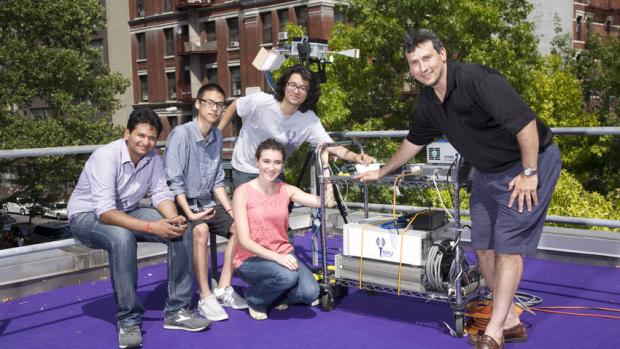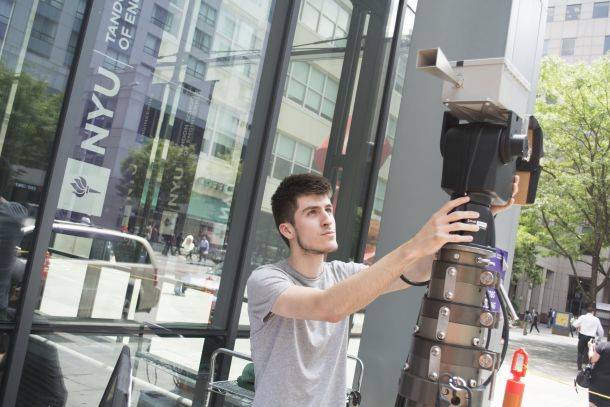Dr. 5G
Ted Rappaport and NYU WIRELESS are at the Forefront of 5G Research, and Policy Makers Are Paying Attention

While most members of the general public probably do not take much notice of the Federal Communications Commission (FCC) and its rulings, the organization has a profound effect on how all of us interact with our radios, televisions, satellite and cable systems, and wireless devices.
On July 14 the FCC voted affirmatively on a historic plan — the Spectrum Frontier Proceeding (SFP) — aimed at freeing up unprecedented amounts of bandwidth for the fifth generation (5G) of wireless communication. The ruling effectively quadruples the bandwidth previously available to the mobile industry.
While consumers will enjoy speeds up to 100 times faster than those obtained with 4G devices, the move means much more for the world than effortlessly streaming movies and sharing selfies. Fifth-generation wireless is predicted to usher in an era in which physicians use sophisticated virtual-reality gear to operate from remote locations on patients; cars sharing a road communicate in order to avoid accidents; hundreds of millions of illiterate adults around the globe have access to needed educational materials; and smart buildings make the most efficient possible use of energy.
Much of the bandwidth being made available thanks to the SFP will be in the millimeter wave (mmWave) spectrum (30 to 300 gigahertz), since bands lower on the spectrum are already being used near capacity. Technology here holds the promise of dramatically improving urban reception and reducing the cost of bringing fiber optic-speed WiFi and wireless service to underserved rural areas. Not too long ago, however, few researchers had even recognized the potential of the mmWave spectrum, and most shortsightedly believed that longer waves, because of their proven ability to travel long distances and through buildings, represented the limits of possibility for wireless communications.
It was not until 2013, when the seminal paper “Millimeter Wave Mobile Communications for 5G Cellular: It Will Work” was published in an IEEE journal, that the world awoke to the possibilities of tapping that underutilized spectrum. The paper’s lead author was Ted Rappaport, a professor of electrical and computer engineering at the NYU Tandon School of Engineering and the founding director of NYU WIRELESS, a multidisciplinary academic research center that is creating the fundamental theories and techniques for next-generation mass-deployable wireless devices across a wide range of applications and markets.
Rappaport, who has joint academic appointments at NYU’s Courant Institute of Mathematical Sciences and the Department of Radiology at NYU Langone Medical School, has long been a tireless proponent for the use of mmWave as a spectrum superhighway for 5G. Today he serves as the founding director of NYU WIRELESS, and Professor Sundeep Rangan directs the center, which draws faculty and students from the three schools of NYU and a level of support from global industry affiliates that is rare in academia.
In public comments filed with the FCC in 2014 and 2015, NYU WIRELESS warned that the U.S. would need to act fast or fall behind. Those comments and opinions were embraced by a large segment of the telecom community, and, ultimately, the FCC — recognizing the irrefutable nature of Rappaport’s 20-year research into millimeter wave technology — announced the SFP on October 22, 2015.
At the FCC 5G Spectrum Frontiers workshop held on March 10, 2016, Rappaport gave the keynote address and explained that implementing the proposal would have enormous benefits for all concerned. “It basically doubles WiFi spectrum availability,” he said. “While it benefits existing carriers with 28 GHz and 38 GHz licenses, the U.S. public is the big winner: Because the proposal makes unbelievably large spectrum availability for both licensed and unlicensed use, entrepreneurs can employ new networks, including low-cost WiFi and service delivery, such as NYC City Internet, as well as the projected 50 billion Internet of Things (IoT) devices that could be coming online.”

Undergraduate student Jeton Koka (Computer Science and Computer Engineering) inspects the mmWave channel sounder
Because 5G opens the possibility of better service in rural regions as well as in densely populated urban areas, Rappaport’s research is helping democratize access to the digital world — an outcome that speaks directly to NYU Tandon’s core goal of creating technology that will serve society.
FCC Chairman Tom Wheeler is firmly behind that mission and has pointed out that with the implementation of the FSP, the U.S. will become the first nation in the world to open high-band spectrum for 5G networks. During a recent speech in Washington, D.C., he asserted, “Unlike some countries, we do not believe we should spend the next couple of years studying what 5G should be. We won’t wait for the standards to be first developed in the sometimes arduous standards-setting process or in a government-led activity. Instead, we will make ample spectrum available and then rely on a private sector-led process for producing technical standards best suited for those frequencies and use cases.”
NYU WIRELESS — which also counts among its major researchers a dozen NYU Tandon professors and more than 100 engineering faculty and student researchers in all — will be an integral part of that process. Rappaport has announced that the center is making its channel model simulator software and measurement data free to anyone, helping industry to avoid years of development time for mmWave. It is now being predicted that 5G technology could reach consumers by 2018 — well ahead of original projections.
Considering that Rappaport and his NYU WIRELESS colleagues had not completed the groundbreaking research that proved the viability of using the mmWave spectrum on a widespread, commercial basis until about 2012, progress has been exceptionally rapid. We are, many experts agree, at the brink of a technological revolution unlike any other in communications history.
As someone who has devoted more than three decades to the wireless field, holds more than 100 patents, is one of the most highly cited authors on the topic, and made NYU WIRELESS the widely acknowledged world leader in 5G research, Rappaport is a vital part of that history.




